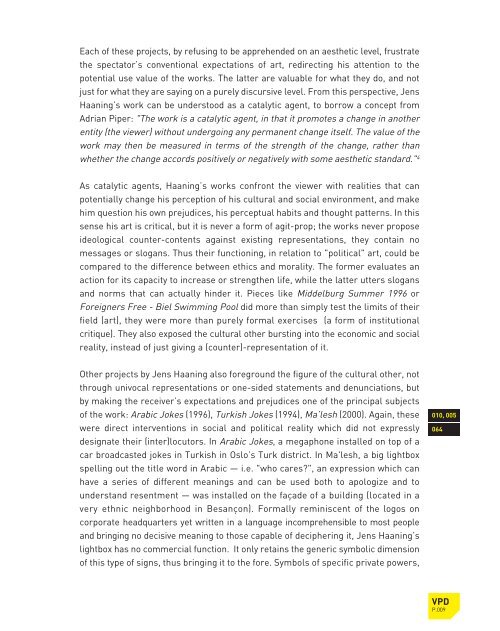download catalogue high resolution pdf (22.3 mb) - Jens Haaning
download catalogue high resolution pdf (22.3 mb) - Jens Haaning
download catalogue high resolution pdf (22.3 mb) - Jens Haaning
You also want an ePaper? Increase the reach of your titles
YUMPU automatically turns print PDFs into web optimized ePapers that Google loves.
Each of these projects, by refusing to be apprehended on an aesthetic level, frustrate<br />
the spectator’s conventional expectations of art, redirecting his attention to the<br />
potential use value of the works. The latter are valuable for what they do, and not<br />
just for what they are saying on a purely discursive level. From this perspective, <strong>Jens</strong><br />
<strong>Haaning</strong>’s work can be understood as a catalytic agent, to borrow a concept from<br />
Adrian Piper: "The work is a catalytic agent, in that it promotes a change in another<br />
entity (the viewer) without undergoing any permanent change itself. The value of the<br />
work may then be measured in terms of the strength of the change, rather than<br />
whether the change accords positively or negatively with some aesthetic standard." 4<br />
As catalytic agents, <strong>Haaning</strong>’s works confront the viewer with realities that can<br />
potentially change his perception of his cultural and social environment, and make<br />
him question his own prejudices, his perceptual habits and thought patterns. In this<br />
sense his art is critical, but it is never a form of agit-prop; the works never propose<br />
ideological counter-contents against existing representations, they contain no<br />
messages or slogans. Thus their functioning, in relation to "political" art, could be<br />
compared to the difference between ethics and morality. The former evaluates an<br />
action for its capacity to increase or strengthen life, while the latter utters slogans<br />
and norms that can actually hinder it. Pieces like Middelburg Summer 1996 or<br />
Foreigners Free - Biel Swimming Pool did more than simply test the limits of their<br />
field (art), they were more than purely formal exercises (a form of institutional<br />
critique). They also exposed the cultural other bursting into the economic and social<br />
reality, instead of just giving a (counter)-representation of it.<br />
Other projects by <strong>Jens</strong> <strong>Haaning</strong> also foreground the figure of the cultural other, not<br />
through univocal representations or one-sided statements and denunciations, but<br />
by making the receiver’s expectations and prejudices one of the principal subjects<br />
of the work: Arabic Jokes (1996), Turkish Jokes (1994), Ma’lesh (2000). Again, these<br />
were direct interventions in social and political reality which did not expressly<br />
designate their (inter)locutors. In Arabic Jokes, a megaphone installed on top of a<br />
car broadcasted jokes in Turkish in Oslo’s Turk district. In Ma'lesh, a big lightbox<br />
spelling out the title word in Arabic — i.e. "who cares?", an expression which can<br />
have a series of different meanings and can be used both to apologize and to<br />
understand resentment — was installed on the façade of a building (located in a<br />
very ethnic neighborhood in Besançon). Formally reminiscent of the logos on<br />
corporate headquarters yet written in a language incomprehensible to most people<br />
and bringing no decisive meaning to those capable of deciphering it, <strong>Jens</strong> <strong>Haaning</strong>’s<br />
lightbox has no commercial function. It only retains the generic sy<strong>mb</strong>olic dimension<br />
of this type of signs, thus bringing it to the fore. Sy<strong>mb</strong>ols of specific private powers,<br />
010, 005<br />
064<br />
VPD<br />
P.009


